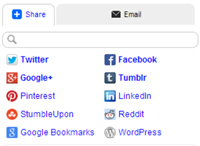 If you are just starting a blog or not getting any visitor interaction, have you taken the time to make sure that your blog has all the right parts under the hood? Many sites available for setting up blogs, for example WordPress or Tumblr, have templates or plug-ins available that assist with making sure you have what you need. But, there are some sites out there that may not be as vibrant or provide the necessary templates and tools.
If you are just starting a blog or not getting any visitor interaction, have you taken the time to make sure that your blog has all the right parts under the hood? Many sites available for setting up blogs, for example WordPress or Tumblr, have templates or plug-ins available that assist with making sure you have what you need. But, there are some sites out there that may not be as vibrant or provide the necessary templates and tools.
This checklist may contain obvious items to many, but you would be surprised at how many of them go unused or are used incorrectly. The mechanics behind setting up your blog are just as important as the content that you put into it. Remember, your goal is interaction with your visitors – whether they are sharing your content, sharing your site, leaving a comment, or contacting you.
Use this checklist when setting up or updating your blog to ensure your visitors have the necessary tools for interaction and enhancing their experiences.
- Social Media Buttons. Be sure that your blog not only has social media buttons for the main blog, but for each post as well. This allows your visitors to share your blog as well as specific posts of interest. The more options that you can give your visitors to share your content, the better chance you have of attracting new visitors and keep existing visitors coming back.
- Always be sure that your buttons lead visitors to the correct place. I recently visited a blog where the main site’s social media buttons took me to the accounts of the template creator and NOT the blog owner’s accounts.

- Email Subscriptions or Newsletter Signups. Email subscriptions allow your visitors to sign up to receive an email every time your blog has a new post. Newsletter signups are great if you send out newsletters via email. Either way, this provides a way for visitors to see what is new on your blog so they can head back over to it.
- Always test this feature. There is nothing worse than signing up to receive a blog notification or newsletter and never receiving an email – only to visit the blog later and see there have been new posts that I missed.
- Contact Form or Email Contact. Always give your visitors a way to contact you. Many templates have a contact form where the visitor fills out the appropriate information such as name, email address, website, subject, and message. If you use a template or site that does not have this feature available then you should provide a linked email address for your visitors to easily contact you.
- Make sure that your contact options actually work. Visitors do not want to click the Submit button on your contact form and receive an error message or send an email to you and receive an undeliverable message in return.

- Comments for Posts. Again, most templates and blogs will have a comment section below each post for your visitors to provide feedback. Be sure to check for that feedback often if you are moderating comments before they appear on your blog (which you should definitely do). Remember to check for comments often if the site does not use a notification system. And of course, always respond to comments left by your visitors.
- Type a test comment after you create post. Again, there is nothing worse than clicking the Submit button after I leave a comment, only to receive an error message.
- Post Categories or Search. When publishing a post, be sure to put it into one or more categories and have a category search feature in your navigation. Although your blog is most likely themed per a specific genre or topic, each post may have something a little different than the others. For example, you may have a blog about writing and posts to fit that topic. But, if you do one post about writing for the Web and another post about writing fiction, be sure to have categories for each of those writing types (Web content / Fiction). This will make it much easier for your visitors to find specific posts if they choose.
- Check your categories or search feature to be sure they are displaying the correct posts. If you do not see a post that you expected, research it. — Did you forget to mark a category? Is there something wrong with the category or search feature?

- Test Your Blog! This is something that I see a lot of bloggers NOT doing and it is one of the most important things you can do. Once your blog is set up, be sure to test all of the above items as mentioned. Also be sure to click every link and every page in your blog. Leading your visitors astray will reduce the chances of them coming back or sharing your content. An aggravated visitor is most likely not a return visitor.
- If you include a link in your post, click it to make sure it takes the visitor to the intended location. I have visited blogs where a link provided would be helpful, but instead it took me to a non-existent page.
- Click through every tab, page or navigational link to be sure they work. I have also visited blogs where a main navigational page of the blog took me to a “page not found”.
These two final pieces are geared towards the look and feel of your blog and should always be kept in mind.
- Consistency. Be sure that if you are not using a templated site that you remain consistent throughout your entire blog. Headers, footers, logos, navigation – should remain consistent everywhere and on every page of your blog. For example, do not use a different logo on the main page than you do on your About Us or Contact Us pages.
- Images for Each Post. Images are eye-catchers and can add that “curb appeal” to your main page and posts. Always try to include at least one image with every post – more for longer posts. The images do not have to be extravagant and can be easily created from a screen shot or inserted from a website that allows public usage such as Stock.xchng. Regardless of where you obtain the image, be sure to use those that apply to the post and give proper credit.
You do not have to be a Web Developer to set up a blog. There are many sites offering easy-to-use templates, plug-ins, and features to help set up the simplest blog in no time. When searching for a site to use for your blog it is best research a few first to see if it offers these features – or, check out some of your favorite blogs to see which sites and templates they use.
Have I forgotten any key, under-the-hood parts for setting up a blog? Or, do you have more that you would like to share? We would love to hear from you!
Other helpful articles from Social Media Sun:
- How Do You Write Great Regular Content? My 7 Secret Tips
- 5 Tips to Handle Internet Writing Like a Professional
- Why Aren’t People Sharing Your Content?
Image: Chessboard
- 6 Great Image Tools to Spruce Up Your Website - October 5, 2024
- You Blogged Down a Hill You Can’t Write Back Up - March 20, 2022
- 3 C’s of Content Creation - June 27, 2018
- 3 Easy Ways to Pay Attention to Your Connections - April 28, 2018
- Guidelines for Your Writers and Bloggers Please - December 20, 2017
- 5 Tips to Handle Internet Writing Like a Professional - November 16, 2017
- Great Social Media, Marketing, or Blog Planning Apps - October 2, 2017
- Spring Forward With a Renewed Look for Your Brand - March 9, 2015
